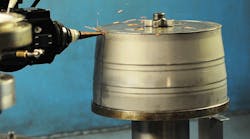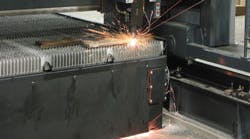Multi-axis laser processing is a high-tech specialty, and a process that’s much in demand for high-value parts, but its just one of several precision manufacturing services available from Ace Precision Machining Corp., in Oconomowoc, Wis. What sets apart this one-stop contract manufacturer is the thoroughness of its laser processing capabilities, along with facility for large-scale metal joining, CNC machining, metal forming, and thermal processing.
Ace Precision presents itself as a strategic manufacturing partner for OEMs and chain suppliers in aerospace, power generation, and defense production. By doing all operations in-house, without depending on subcontractors, Ace Precision noted it reduces turnaround time on projects and eliminates issues that may occur when using a third-party supplier.)
"Almost nothing is outsourced," according to Ed Magedanz, Ace Precision senior manufacturing engineer.
"Because our facilities and trained people encompass all areas of metal forming, fabrication, and testing, the company maintains process control from start to finish,” he continued. “We work on large projects that involve prototype development over many months, before actual quantity manufacturing takes place. When the project ramp-up occurs, we are ready with the right equipment and the trained personnel to deliver as required.
“Our track record with multi-axis laser processing is a great example of how we provide all of our contract services to the benefit of our many customers," Magedanz said.
Opportunity in Turbine Production
Ace Precision laser processes various different materials, and it has capitalized on growth opportunities in the industries that have seen rapid increase in demand for laser processing. These include the shops longtime OEM customers Honeywell, Rolls-Royce, and Siemens. Others include global manufacturers that require components and assemblies processed with multi-axis laser systems.
"The aerospace and turbine industry has made a large move to cooling combustion components with effusion holes," Magedanz detailed. "These are small holes drilled through the part at steep angles. In many cases, where parts are thermal barrier-coated, our Nd:YAG lasers are the only way to provide these steep angled holes efficiently, and with accuracy.
We continue to grow our laser department by acquiring the latest technology to take advantage of these new industry trends, and to provide the versatility with different laser system models to handle these and a growing range of projects."
Ace Precision's dedication to Laserdyne systems goes back to its beginnings and now includes four CO2 systems with up to eight axes of motion, five multi-axis BeamDirector drilling systems with Nd:YAG lasers, and a shuttle-equipped 2D cutting system. Together, these systems provide the capacity, flexibility and precision required to produce highly complex combustion chambers, liners, turbine plenums, compressor housing, tailpipe and heat shield assemblies along with other precision engine components.
The materials for these components and assemblies are varied, and include cobalt, nickel, stainless steels, and aluminum in thickness from 0.005 to 0.500 inch. The nickel and cobalt based high temperature alloys are especially challenging and include Haynes® 625, 188, 230 and 718.
The Right Equipment, Trained Personnel
With seven Laserdyne multi-axis laser systems in-house already, Ace Precision recently added two new 795XL systems to process complex parts needed for a military vehicle project. In development, and through prototype stages over a two-year period, when the project went into volume production Ace Precision was ready with the newest Laserdyne systems.
"This is how we handle major projects and use our broad range of precision processes," according to Magedanz. "It gives us the advantage of faster turnaround because we are using the very latest, high-speed laser systems with the highest repeatable quality level established during the prototype stages of the project."
"One of the best things about working with Laserdyne equipment is that even though the technology has evolved over the years, their program structure is still the same," offered Kurt Magedanz, process engineer. "We can take a program from one of our older laser systems and put it into one of the newest laser systems, and it will operate with no changes — even with a completely different laser source and a controller that is two generations newer.
“We accomplished that by taking the part programs from the older lasers for the prototype work, and then moving them to the newer and faster systems when we move into volume production. It's a real time-saver and our system operators like it because there is minimal learning required to operate the newer systems."
Ace Precision’s latest two Laserdyne 795XL systems are capable of seven axes of motion, with a 2x1x1 meter (80x40x40 inches) work envelope that includes two high-accuracy rotary tables. The structure of these laser systems makes it possible to process small to large part configurations in all seven axes, which provides the flexibility Ace Precision needs to handle a range of projects with repeatable precision.
"Our Nd:YAG lasers are capable of drilling effusion-cooled holes in very dense patterns, at shallow angle holes with diameter tolerances of less than 0.002 inch,” noted Kurt Magedanz. “Methods of achieving these effusion-cooled holes are: deep hole drilling, percussion drilling, trepan drilling and drilling on the fly."
Integrated Design and Production
Achieving a high level of accuracy from prototype to production stages, and from one job to another, is possible because of the way that Laserdyne designs and integrates its system features. Everything works together because design and manufacturing are fully integrated — from the controller, software, and motion system to the laser and process sensors.
An example is Laserdyne’s Automatic Focus Control (AFC™) feature, highly popular with users, and one that Ace Precision helped to refine with its feedback to Laserdyne engineers.
AFC guides the motion system, maintaining critical focus position and following the contour of a part regardless of slight surface irregularities. With this control capability, all machine axes react to sensing of the part surface, creating unlimited R-axis correction with high speed and unmatched sensitivity. AFC makes it possible for machines to reach top speeds, so productivity is maximized without downtime or scrap.
AFC is used by Ace Precision for trepanning, percussion drilling, and drilling on the fly.
Trepanning is a process for creating holes as a part is held stationary and the laser beam is moved with simultaneous multiple action motion, to create a round hole or any feature by cutting the periphery of the shape. Laserdyne's accurate and repeatable laser positioning allows for very unique and tight tolerance trepanned features.
In contrast, percussion drilling delivers one or more pulses from the laser to a part while the laser beam and part are stationary. More than one pulse may be required depending on the material type and thickness.
A variation of percussion drilling is “drill on the fly,” in which pulses are delivered to the part by the stationary laser while the part is rotated. The hole placement is a function of rotational speed and laser pulse frequency. If multiple pulses are required, drill-on-the-fly software developed by Laserdyne engineers is used to synchronize the movement of the part to the laser pulses, ensuring that multiple pulses are delivered to the exact location required. By changing the laser pulse energy, pulse count, or lens focal length, the characteristics of the drilled hole size and taper can be controlled to meet the requirements of the part. Drill-on-the-fly software also allows changes of the pulse shape during the process to improve hole geometry.
“Repeatability (±0.0001 inch) of the laser system really comes into play on our jobs,” Magedanz commented. "Our Laserdyne BeamDirectors with their AFC features are designed so we maintain this accuracy with consistency through the entire work envelope.”
Finding New Laser Solutions
"The best thing about working with Laserdyne is the company’s willingness to work with us to find a solution when we have a complex part, one that needs an ‘outside the box’ approach to laser processing," he reflected. "By doing so, we come away with a solution to our problem, and Laserdyne gets to use the experience to develop new technology for integration into future systems."
"Our new Laserdyne systems — together with our other seven laser systems — show our capabilities, and their depth, and how we use Laserdyne-supplied systems to the benefit of our customers," Magedanz reported. "This also applies to our machining, metal forming, thermal processing and other precision services. In the chip cutting area for example, we have over 50 CNC machines -- vertical mills, horizontal mills, turning centers and more. We're positioned so our business ensures redundant capabilities in two separate facilities to manage risk and provide timely and reliable service to customers around the world."







